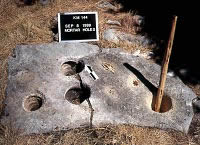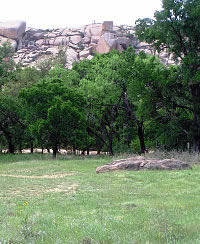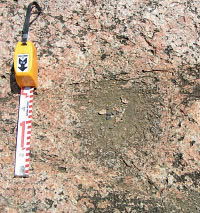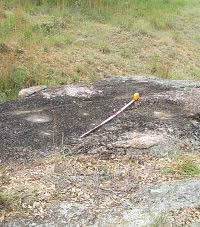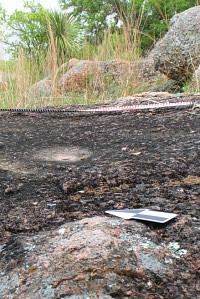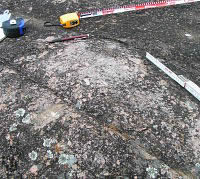The Bedrock Mortars of Enchanted Rock
Some archeological sites are monumental, spectacular, and awe inspiring, such as the dry rockshelters adorned with painted walls in the Lower Pecos Canyonlands. Other ancient places are more subtle and hidden in nature, offering a quieter story of everyday life in prehistoric Texas. Such are the stories told by the bedrock mortars of Enchanted Rock State Natural Area, located in Gilliespie and Llano Counties between Fredericksburg and Llano.
Bedrock mortars are the ancient equivalent to our modern day Cuisinart food processors, for it is in these features that foods�usually plant foods�were crushed, ground, and otherwise converted into flour or meal, using a wooden or stone tool called a pestle. This activity was sufficiently frequent and intensive that it literally modified the granite surfaces where the work occurred. In many cases, the pulverizing action of the pestle, perhaps coupled with acids present in the foods being worked, created saucer-shaped depressions in the granite. In other instances, the activity produced smooth, polished surfaces that can still be found today, but are so subtle that few are ever noticed and documented. Today, many grinding features are present and visible on a number of granite outcrops within the park, even though they were probably last used millenia ago.
Enchanted Rock bedrock mortars have a distinctive form not common elsewhere in Texas. This may be due to the nature of the granite bedrock itself, which is hard, dense, and has a crystaline structure not seen in limestone or sandstone, the rock types that host bedrock mortars elsewhere in the state. But the distinctive form of Enchanted Rock mortars may also be due to differences in ancient cultural practices or preferences as well as the slightly different mix of native foods available in the area. The acidic, gravelly, well-drained soils common to the Llano Uplift host a number of plant species that normally aren�t found in the surrounding Texas Hill Country where limestones or sandstones predominate. While live oak and red oak are the dominate species on the surrounding Edwards Plateau, blackjack and post oaks are common in the Llano Uplift.
These and other plants have formed a historically unique set of resources that dictated the food choices made by the ancient peoples who lived at Enchanted Rock. As a rule, plant foods were a much larger dietary component that meat for the native peoples of the region throughout the prehistoric era. Man the hunter would not have survived long without woman the gatherer. It is highly likely that throughout the Plateaus and Canyonlands region, women were not only the bread-makers, but also the primary bread-winners for their families as measured in cold, hard calories. Based on worldwide cultural patterns, bedrock mortars and pestles were almost certainly women�s work areas and women�s tools.
The bedrock mortars found at Enchanted rock are relatively small, shallow features that can be very tricky to spot, even with an experienced eye. They are found on low granite benches or outcrops, usually near or within spots that have other types of archeological materials (flint flakes, burned rock, etc). These benches can reveal any number of mortars. Single mortars are found, but most commonly they tend to occur in clusters. The mortars themselves are typically shallow, circular, saucer-shaped depressions about 8 inches in diameter and less than 1 inch in depth.
The Enchanted Rock mortars show several contrasting wear patterns. Some bedrock mortar surfaces have hundreds of tiny fractures, created by countless pestle impacts to the mortar surface as the mortar was being used to pulverize foods into flour or meal. In contrast, other surfaces are slick and polished by wear, suggesting they have been worn by grinding. These contrasting wear patterns allow clear distinctions between grinding surfaces (metates) and pounding surfaces (mortars), even when they overlap on a single bedrock bench.
Keep in mind bedrock features are only part of the plant-processing tool kit, and that they didn�t function in isolation. Perishable tools (including food containers for storage and transport, sifting and winnowing baskets, and in some cases wooden pestles, to name just a few) would have been an integral part of the plant processing that took place at these spots. These organic tools rotted away within a few years. There would have been characteristic stone tools�pestles and handstones (manos)�that would have survived the elements, but few of these are found simply because they are obvious artifacts that the curious collector must have. The bedrock metates of Enchanted Rock were more likely used with �manos� or hand-stones. While no pestles have yet been documented at Enchanted Rock archeological sites, manos are quite common, and were presumably used both as grinding tools and shelling nuts.
Contributed by Dan Potter, archeologist, Texas Historical Commission.
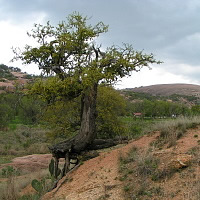
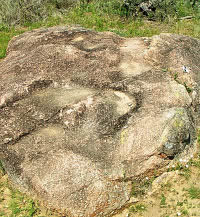
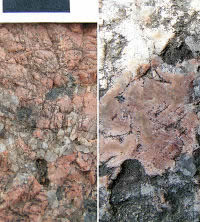
In contrast, the bedrock metate surface at right (shown at a slightly higher level of magnification) shows a much different wear pattern. Here, a single pink feldspar crystal has been sliced and polished by grinding. Pitting around the edges of the crystal suggests that some smaller crystals have been removed by the grinding process, but the impact fracturing so typical of mortar surfaces is completely absent. These contrasting wear patterns allow clear distinction between grinding surfaces (metates) and pounding surfaces (mortars), even when they overlap on a single bedrock bench. Photos by Dan Potter, Texas Historical Commission.

